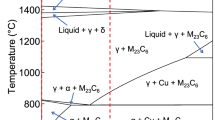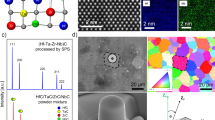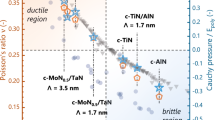Abstract
Nitride coatings are increasingly demanded in the cutting- and machining-tool industry owing to their hardness, thermal stability and resistance to corrosion. These properties derive from strongly covalent bonds; understanding the bonding is a requirement for the design of superhard materials with improved capabilities. Here, we report a pressure-induced cubic-to-orthorhombic transition at ≈1 GPa in CrN. High-pressure X-ray diffraction and ab initio calculations show an unexpected reduction of the bulk modulus, K0, of about 25% in the high-pressure (lower volume) phase. Our combined theoretical and experimental approach shows that this effect is the result of a large exchange striction due to the approach of the localized Cr:t3 electrons to becoming molecular-orbital electrons in Cr–Cr bonds. The softening of CrN under pressure is a manifestation of a strong competition between different types of chemical bond that are found at a crossover from a localized to a molecular-orbital electronic transition.
This is a preview of subscription content, access via your institution
Access options
Subscribe to this journal
Receive 12 print issues and online access
$259.00 per year
only $21.58 per issue
Buy this article
- Purchase on Springer Link
- Instant access to full article PDF
Prices may be subject to local taxes which are calculated during checkout




Similar content being viewed by others
References
Kaner, R. B., Giman, J. J. & Tolbert, S. H. Designing superhard materials. Science 308, 1268–1269 (2005).
Tong, W. P., Tao, N. R., Wang, Z. B., Lu, J. & Lu, K. Nitriding iron at lower temperatures. Science 299, 686–688 (2003).
Esaka, R. et al. Comparison of surface oxidation of titanium nitride and chromium nitride films studied by X-ray absorption and photoelectron spectroscopy. J. Vac. Sci. Technol. A 15, 2521–2528 (1997).
Gregoryanz, E. et al. Synthesis and characterization of a binary noble metal nitride. Nature Mater. 3, 294–297 (2004).
Grossman, J. C. et al. Transition metals and their carbides and nitrides: Trends in electronic and structural properties. Phys. Rev. B 60, 6343–6347 (1999).
McMillan, P. F. New materials from high-pressure experiments. Nature Mater. 1, 19–25 (2002).
Subramanya Herle, P., Hegde, M. S., Vasathacharya, N. Y. & Philip, S. Synthesis of TiN, VN and CrN from ammonolysis of TiS2,VS2, and Cr2S3 . J. Solid State Chem. 134, 120–127 (1997).
Gall, D., Shin, C-S., Haasch, R. T., Petrov, I. & Greene, J.E. Band gap in epitaxial NaCl-structure CrN(001) layers. J. Appl. Phys. 91, 5882–5886 (2002).
Corliss, L. M., Elliott, N. & Hastings, J. M. Antiferromagnetic structure of CrN. Phys. Rev. 117, 929–935 (1960).
Browne, J. D., Liddell, P. R., Street, R. & Mills, T. An investigation of the antiferromagnetic transition of CrN. Phys. Status Solidi A 1, 715–723 (1970).
Filippetti, A. & Hill, N. A. Magnetic stress as the driving force of structural distortions: the case of CrN. Phys. Rev. Lett. 85, 5166–5169 (2000).
Angel, R. J. High-Temperature and High-Pressure Crystal Chemistry (Reviews in Mineralogy and Geochemistry, 41, Mineralogical Society of America, 2000).
Chen, H. Y., Tsai, C. J. & Lu, F. H. The Young’s modulus of chromium nitride films. Surf. Coat. Technol. 184, 69–73 (2004).
Aizawa, T., Kuwahara, H. & Tamura, M. Fabrication of CrN/Cr2N bulk composites and their mechanical properties. J. Am. Ceram. Soc. 85, 81–85 (2002).
Crowhurst, J. C. et al. Synthesis and characterization of the nitrides of platinum and iridium. Science 311, 1275–1278 (2008).
Shebanova, O., Soignard, E. & McMillan, P. F. Compressibilities and phonon spectra of high-hardness transition metal-nitride materials. High Press. Res. 26, 87–97 (2006).
Cumberland, R. W. et al. Osmium diboride, an ultraincompressible, hard material. J. Am. Chem. Soc. 127, 7264–7265 (2005).
Yu, R., Zhan, Q. & De Jonghe, L. C. Crystal structures of and displacive transitions in OsN2, IrN2, RuN2, and RhN2 . Angew. Chem. Int. Ed. Engl. 46, 1136–1140 (2007).
Young, A. F. et al. Synthesis of novel transition metal nitrides IrN2 and OsN2 . Phys. Rev. Lett. 96, 155501–155504 (2006).
Chhowalla, M. & Unalan, H. E. Thin films of hard cubic Zr3N4 stabilized by stress. Nature Mater. 4, 317–322 (2005).
Meng, Y. et al. The formation of sp3 bonding in compressed BN. Nature Mater. 3, 111–114 (2004).
Goodenough, J. B. Magnetism and the Chemical Bond (Wiley, 1963).
Goodenough, J. B. & Rivadulla, F. Bond-length fluctuations in transition-metal oxides. Mod. Phys. Lett. B 19, 1057–1081 (2005).
Goodenough, J. B., Dutta, G. & Manthiram, A. Lattice instabilities near the critical V–V separation for localized versus itinerant electrons in LiV1−yMyO2 (M=Cr or Ti)Li1−xVO2 . Phys. Rev. B 43, 10170–10178 (1991).
Radaelli, P. G. et al. Formation of isomorphic Ir3+ and Ir4+ octamers and spin dimerization in the spinel CuIr2S4 . Nature 416, 155–158 (2002).
Schmidt, M. et al. Spin singlet formation in MgTi2O4: Evidence of a helical dimerization pattern. Phys. Rev. Lett. 92, 56402–56405 (2004).
Anderson, P. W. New approach to the theory of superexchange interactions. Phys. Rev. 115, 2–13 (1959).
Harrison, W. A. Electronic Structure and the Properties of Solids. The Physics of the Chemical Bond (W. H. Freeman, 1980).
Bloch, D. The 10/3 law for the volume dependence of suprexchange. J. Phys. Chem. Solids 27, 881–885 (1966).
Zhou, J.-S. & Goodenough, J. B. Pressure-induced transition from localized electron toward band antiferromagnetism in LaMnO3 . Phys. Rev. Lett. 89, 87201–87204 (2002).
Haines, J. & Leger, J. M. Phase transitions in ruthenium dioxide up to 40 GPa: Mechanism for the rutile-to-fluorite phase transformation and a model for the high-pressure behaviour of stishovite SiO2 . Phys. Rev. B 48, 13344–13350 (1993).
Lennie, A. R., Laundy, D., Roberts, M. A. & Bushnell-Wye, G. A novel facility using a Laue focusing monochromator for high-pressure diffraction at the SRS, Daresbury, UK. J. Synchrotron. Radiat. 14, 433–438 (2007).
Schwarz, K. & Blaha, P. Solid state calculations using WIEN2k. Comput. Mater. Sci. 28, 259–273 (2003).
Sjöstedt, E., Nördstrom, L. & Singh, D. J. An alternative way of linearizing the augmented plane-wave method. Solid State Commun. 114, 15–20 (2000).
Perdew, J. P., Burke, K. & Ernzerhof, M. Generalized gradient approximation made simple. Phys. Rev. Lett. 77, 3865–3868 (1996).
Lichtenstein, A. I., Asinimov, V. I. & Zaanen, J. Density-functional theory and strong interactions: Orbital ordering in Mott–Hubbard insulators. Phys. Rev. B 52, R5467–R5470 (1995).
Acknowledgements
B. Dacuña from the X-ray service of USC (Spain) is acknowledged for his help during the thermal X-ray experiments, as are A. Lennie, S. Blanco-Canosa and M. Otero-Leal for their collaboration in the high-pressure X-ray experiments at Daresbury SRS. C. Serra from the University of Vigo, Spain, is acknowledged for the X-ray photoemission spectroscopy analysis. We acknowledge financial support from Xunta de Galicia (PXIB20919PR and O8PXIB236053PR) MEC of Spain (MAT2009-08165) and the Robert A. Welch Foundation of Houston, TX (Grant F-1066).
Author information
Authors and Affiliations
Contributions
F.R. conceived the project, synthesized the samples, carried out the synchrotron and magnetic experiments, analysed the results and wrote the paper. M.B.-L. carried out and analysed the synchrotron X-ray data and participated in the discussion. C.X.Q. made electrical and thermal conductivity measurements, and collaborated in the synthesis. A.P., V.P. and D.B. carried out the ab inito calculations and participated in the discussions. M.A.L.-Q. and J.R. participated in the discussion. C.A.R. and H.S. measured the thermal expansion and Young modulus. J.-S.Z. carried out high-pressure X-ray experiments. J.B.G. participated in the discussion and wrote the paper.
Corresponding author
Supplementary information
Supplementary Information
Supplementary Information (PDF 433 kb)
Rights and permissions
About this article
Cite this article
Rivadulla, F., Bañobre-López, M., Quintela, C. et al. Reduction of the bulk modulus at high pressure in CrN. Nature Mater 8, 947–951 (2009). https://doi.org/10.1038/nmat2549
Received:
Accepted:
Published:
Issue Date:
DOI: https://doi.org/10.1038/nmat2549
This article is cited by
-
Investigation of the Damage Mechanism of CrN and Diamond-Like Carbon Coatings on Precipitation-Hardened and Duplex-Treated X42Cr13/W Tool Steel by 3D Scratch Testing
Journal of Materials Engineering and Performance (2022)
-
Structural and Magnetic Properties of CrN: Investigated by First-Principles Calculations, Monte Carlo Simulation, and High-Temperature Series Expansions
Journal of Superconductivity and Novel Magnetism (2020)
-
Elastic stability and optical property under pressure of TiN phases: by first principles study
Indian Journal of Physics (2017)
-
Elastic, magnetic and electronic properties of iridium phosphide Ir2P
Scientific Reports (2016)
-
Effect of glycine on the synthesis of CrN nanopowder using nitridation combustion synthesis precursors
Journal of Nanoparticle Research (2015)



